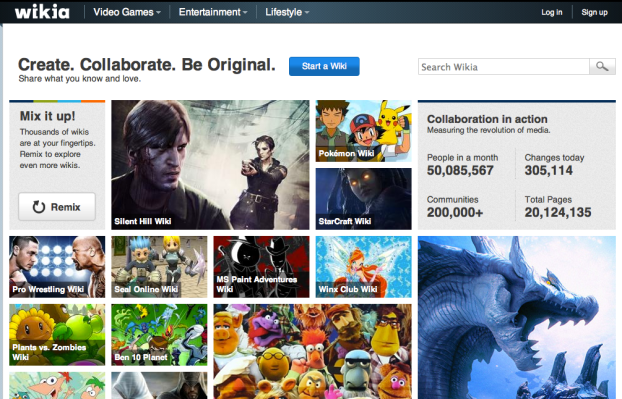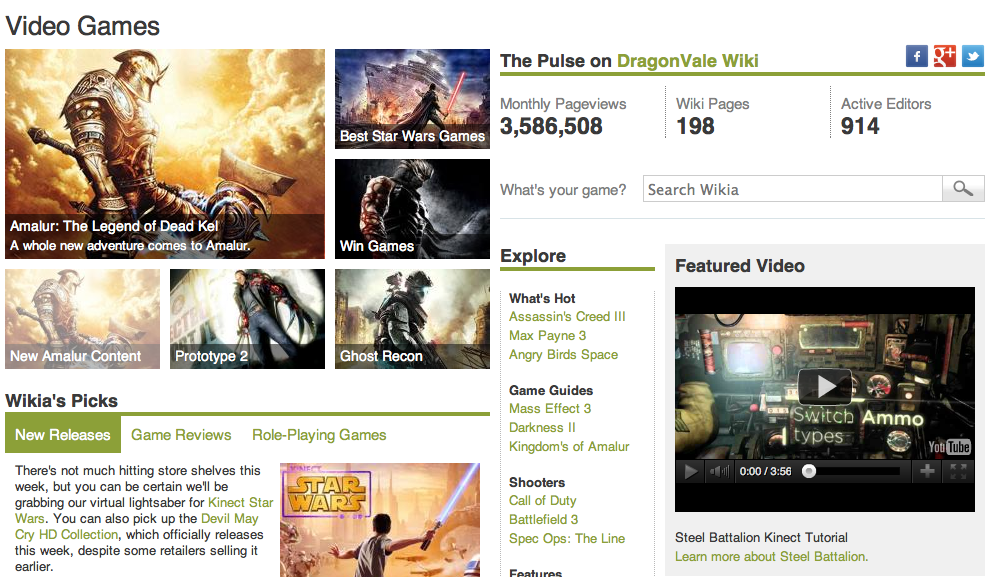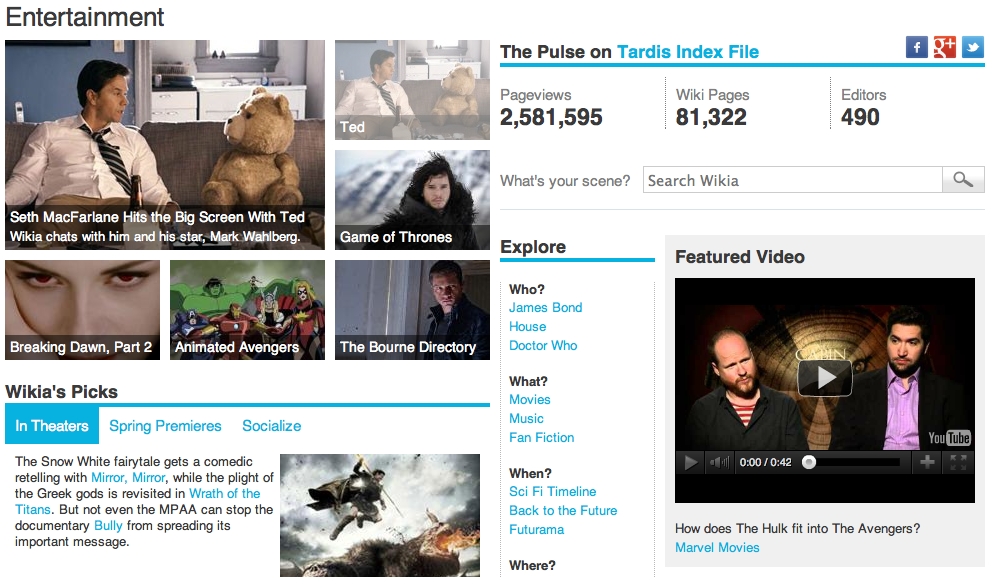You may not be familiar with Wikia, but the collaborative media company has been quietly growing into a giant, recently passing IGN, for example, as the largest network of gaming sites on the planet. Led by both its gaming and entertainment verticals, Wikia’s content-driven social network is home to one of the largest and most active communities on the Web. For those unfamiliar, building on the popularity of its non-profit predecessor (Wikipedia), the site allows anyone (even you) to create new communities around any subject they’re passionate about — or participate in one of its 200,000 existing communities — for free.
Wikia now boasts 20 million pages of user generated content, all of which are viewed by 50 million-plus global visitors each month. So, really, if you’ve come across any wiki outside the confines of Wikipedia — be it an article, a video, a review, or a demo — it’s likely that sucker was created by a Wikia user. The open, collaborative nature of Wikia’s content production, minus the hierarchy of a traditional media platform, has proven surprisingly successful in and of itself. Thanks to a simple ad-supported rev model, Wikia CEO Craig Palmer says that the company has managed to remain “profitable for years.”
However, as publishing models change, Wikia is looking to more strategically marry the world of professional content creation with the open, free-for-all of UGC, without fundamentally changing or restricting the formula that got it here. As its communities have been largely disaggregated and separate from one another, Wikia is today officially unveiling its biggest redesign in years, which aims to collect its communities under one, sleek-looking roof while improving both engagement and discovery for a more mainstream audience (i.e. new users).
To do so, the company has launched new category “hub pages” that will curate the site’s content into entertainment, gaming, and lifestyle verticals, which makes it significantly easier for users to interact with pages according to preference and to discover new, previously obscured Wikia content. It’s also a move aimed at more effectively piquing the interest of advertisers, which will be able to expand their footprint beyond individual articles to category verticals and the front page — both of which, as the site’s new entry points, will likely be seeing increased, and more targeted traffic. After all, Wikia is a for-profit enterprise, and advertisers keep the wheels spinning.
All in all, the site’s new look is far more professional in the way it’s visually representing its UGC, giving its portals an editorial, magazine-like interface — a change that may seem drastic to core users, but will be far more familiar in terms of navigation and browsing for first-timers.
The content Wikia will be surfacing on its front page and in each hub will continue to be fueled by the community, through promoted submissions and by way of popularity as measured by the amount of traffic. On top of that, probably the coolest feature of the redesign would be its new remix function, which allows users to shuffle top content with the click of a button, introducing new wikis to browse, etc. (not unlike Wikipedia’s “random page” option).
The new home and hub pages now display current wiki stats, not only making it easier to find out how many people are visiting per month, or the number of edits made on a given day, but to discover trending content, including top picks, popular videos, etc.
Without a doubt, Wikia’s new design has created a much softer landing for new visitors, and it will be up to the hardcore users to determine whether or not their voices still jibe under the new paradigm. The Wikia CEO tells us that he thinks that the site’s new verticals and filtering, in fact, offer a more effective way to make individual voices heard. And that’s really what has made Wikia great, as diving into the depths of communities and individual pages makes one feel as if they’re visiting a meeting of fellow gamers in their basement.
Palmer believes that Wikia’s current trajectory places it in a comparable position to early YouTube. That is to say, the site has a presence, but it really hasn’t established itself as a brand, nor has it created that bullhorn mechanism on behalf of its community. Wikia is sitting on this pandemonium of unique voices, and the CEO thinks it has become imperative to showcase and share the work of those active, and loyal community members. In the long run, Wikia is looking to find ways to bring these users increased exposure, and a more meaningful voice.
In the same way bloggers and YouTube’s videographers have turned passions into careers, Palmer said that the company is set on finding the most effective way to do that for its users. If that means taking a cue from YouTube and creating channels, or offering some sort of hybrid profile, Wikia will likely consider it. But, in the meantime, an aggregated, hub-centered redesign is a good start.
Certainly, the other side of creating a more refined editorial ecosystem is intended to strengthen the site’s appeal to brands and advertisers. With its redesign in place, Wikia will look to expand these relationships, bringing in pre-release content from movie or game studios, for example, to build early, organic excitement for a new title, or increase its reach post-release.
In sum, it provides a telling snapshot of Wikia’s evolution, and it will be interesting to see how the company walks the line between niche and mainstream, and professional content and good, old-fashioned UGC.
For more, check out the new Wikia at home here.


